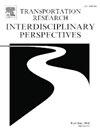Three-dimensional transport poverty and its socio-demographic and urban density predictors: Spatial regression analyses of neighborhoods in the Amsterdam metropolitan area
IF 3.9
Q2 TRANSPORTATION
Transportation Research Interdisciplinary Perspectives
Pub Date : 2025-01-01
DOI:10.1016/j.trip.2025.101340
引用次数: 0
Abstract
Reducing transport poverty can improve well-being and expand employment opportunities. This study investigates the relevance of socio-demographic and urban density predictors in relation to transport poverty contributor metrics for neighborhoods in the Amsterdam metropolitan area. Utilizing a spatial econometric framework, we assess the relevance of these predictors across three dimensions of transport poverty: mobility, accessibility, and affordability. Contrary to existing literature, our findings indicate that the demographic factors of gender and younger age are not significant predictors at the neighborhood level. Furthermore, the research identified a correlation between higher urban density and transport poverty. While higher urban density is associated with decreased car ownership rates and increased accessibility, it simultaneously correlates with higher public transport costs relative to income. Additionally, the method revealed a high cumulative spatial effect of income in connection with transport affordability, indicating spatially extensive income-related transport affordability disparities. Our research offers new insights into factors related to neighborhood-level transport poverty. The observed spatial dynamics call for targeted strategies that address the unique challenges for implementing equitable transport policies in both densely populated urban areas and less urbanized regions.
求助全文
约1分钟内获得全文
求助全文
来源期刊

Transportation Research Interdisciplinary Perspectives
Engineering-Automotive Engineering
CiteScore
12.90
自引率
0.00%
发文量
185
审稿时长
22 weeks
 求助内容:
求助内容: 应助结果提醒方式:
应助结果提醒方式:


